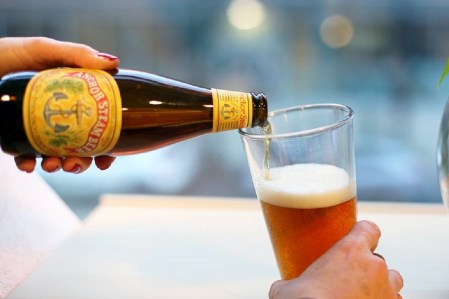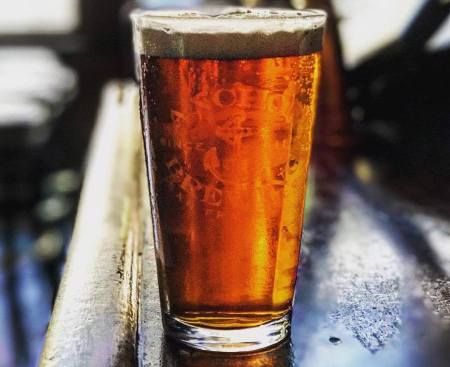
With the sad news the 127-year-old “Grandfather of American craft” Anchor Brewing is ceasing production* we pay homage to where hop profile and accentuation began with our take on their famous Steam Beer. *Recent news reports have given Anchor fans some hope however, as investors are looking into buying the brand via the liquidation process.
When Anchor first started brewing their Steam Beer back in the late 1800s in San Francisco, steam could be seen rising from the open tanks called “coolships” on the rooftop in the icy conditions as they cooled the wort. Those clever folk were taking advantage of the cold conditions before refrigeration was commonplace in brewing and a wonderful beer, which showcases West Coast hops, was born. In turn it would start a hop revolution.
The beer took off and it wasn’t long before it formed its own style and was listed separately in the BJCP style guidelines. This is what the BJCP tells us about a California Steam Beer – now commonly referred to as a California Common after Anchor trademarked the name of their beer in 1981:
Overall impression: a lightly fruity beer with firm, grainy maltiness, interesting toasty and caramel flavours and showcasing rustic, traditional American hop characteristics.
Appearance: medium amber to light copper colour. Generally clear. Moderate off-white head with good retention.
Aroma: typically showcases rustic, traditional American hops (often with woody, rustic or minty qualities) in moderate to high strength. Light fruitiness acceptable. Low to moderate caramel and/or toasty malt aromatics support the hops.
Flavour: moderately malty with a pronounced hop bitterness. The malt character is usually toasty (not roasted) and caramelly. Low to moderately high hop flavour, usually showing rustic, traditional American hop qualities (often woody, rustic, minty). Finish fairly dry and crisp, with a lingering hop bitterness and a firm, grainy malt flavour. Light fruity esters are acceptable, but otherwise clean.
Brew day
A Common is a pretty straight forward beer to brew. Make sure you get some Californian Ale yeast, or even use a lager yeast for the best authentic results and maintain a cool ferment. Brew music has to be some San Fran bands so I’m thinking some Metallica, Creedence, Dead Kennedys, Faith No More…. you get the idea. Now, go brew!

Anchor Steam Beer Clone
All grain (expected figures)
OG: 1.054
FG: 1.013
ABV: 5.3%
IBU: 41
Volume: 20 litres
Ingredients
3.25kg Pale malt
1.25kg Munich (20L) malt
500g Biscuit malt
50g Northern Brewer hop pellets
22g Centennial hop pellets
White Labs Californian Ale Yeast WLP001
Method
- Mash in at 68°C for 60 minutes.
- Sparge and transfer to kettle.
- Once boiling add 30g Northern Brewer hops for a 60 minute boil.
- With 15 minutes left on the boil add 22g Centennial hops.
- Flameout at 60 minutes and add 20g Northern Brewer hops.
- Cool wort to 15°C and run into fermenter.
- Oxygenate or aerate and pitch yeast and maintain 15 to 17°C during fermentation.
- When FG stabilises, keg or bottle as usual.
Extract (expected figures)
OG: 1.054
FG: 1.013
ABV: 5.3%
IBU: 41
Volume: 20 litres
Ingredients
2.4kg Pale malt extract
930g Dark malt extract
500g Biscuit malt
50g Northern Brewer hop pellets
22g Centennial hop pellets
White Labs Californian Ale Yeast WLP001
Method
- Heat 6 litres of water in your brew pot to 70°C.
- Add cracked Biscuit malt in hop or grain bag and mash at 68°C for 30 minutes.
- Remove bag from wort and allow to drain, increase the heat.
- As the water heats up, add half the extract and stir to dissolve.
- Once boiling, add 30g Northern Brewer hops for a 60 minute boil.
- With 15 minutes left on the boil add 22g Centennial hops.
- Flameout at 60 minutes and add 20g Northern Brewer hops.
- Remove from heat and set the pot in a cold/ice water bath to cool for 15 minutes then strain into a fermenter.
- Add the remaining extract then stir to dissolve.
- Top up with cool water to the 17 litre mark and stir vigorously.
- Check the temperature and top up to the 20 litre mark with warm or cold water (refrigerated if necessary) to hit 15°C.
- Pitch the yeast and ferment at 15 to 17°C.
- Keg or bottle as usual.
This recipe appeared in a previous issue of Beer & Brewer. To access multiple recipes every issue, from pros and homebrewers alike, subscribe to our magazine here.


Hi,
This is pretty close to the actual recipe Anchor used 2 row pale ale malt from Great Western malting and crystal/caramel 40L from Briess, the hops used were Nugget and Northern Brewer with Northern Brewer only added last 10 minutes of the boil. The Target SRM is 7 and the IBU target is 34 IBU.
For a 5 gallon batch you would need
8 pounds 8 ounces 2 row pale malt
1 pound crystal/caramel 40L
90 Minute Boil
0.50 Ounces Nugget Hops 90 Minute
0.80 Ounces Northern Brewer Hops 10 Minute
Cool and pitch california lager yeast.
This will get you the actual recipe.